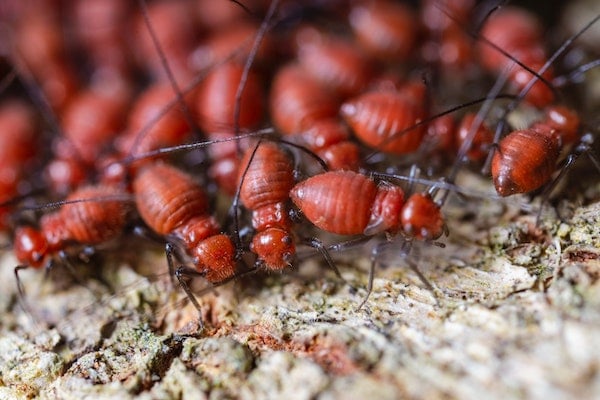Just the mention of termites in your home is enough to terrify any homeowner. These tiny insects can go unnoticed for years wreaking havoc on your home. We’ve all seen homes tented for days to fully eliminate these destructive pests. As a responsible homeowner it’s important to be aware that any home is susceptible. This means that you need to monitor or have someone else monitor your home before an infestation can begin.
Types of Termites In Your Home
Depending on the area that you live in you may be dealing with a few different types.
Subterranean
The most common type of termite is the Subterranean Termite. These live below the ground and build tunnels called mud tubes up the sides of our foundation walls to access the wooden floor structure above. Subterranean Termites can be found throughout the United States; however, they prefer warm climates and are less common the further North you live.
Drywood
Another type of termite is a Drywood Termite. These termites live inside wood creating intricate tunnels throughout it. They are predominantly found along the south border of the United states and in Hawaii. Since they don’t require contact with the soil, they can live unnoticed for long periods of time causing damage to our homes and our furniture.
Dampwood
Dampwood termites are similar to Drywood except that they prefer wet wood. This means any decaying wood located in or around your home may attraction these pests. Leaks from any plumbing lines or abandoned wood piles should be repaired or removed before an infestation starts.
Signs of Termites in your Home
If you’re concerned about they may already be in your home, there are several different signs that you can look for. These signs vary depending on the type of termite you are dealing with.
Subterranean Termites
As we mentioned earlier, Subterranean Termites live in the soil and travel up the sides of your foundation to access the wooden structure above. Keeping an eye out for any tubes is the easiest way to identify a developing problem. However, Subterranean Termites don’t require mud tubes to travel up your walls. Once you see these tubes, it means that they have already been feeding on your structure and have begun to establish your home as their home.
Drywood Termites
Drywood Termites live inside of wood and can be harder to identify until an investigation has occurred. The typical signs are small pieces of wood pellets on the ground below their tunnels. As these termites eat more and more wood, they push out the excrement to keep their tunnels clear. If you notice small round droppings under furniture or any other wooden area it is time to treat for termites.
Dampwood Termites
Another type of termites in your home is the Dampwood Termites. They are more likely to be found underneath or around the outside of your home where there’s any wet or decomposing wood. You’ll be able to see their tunnels inside of the wood if you look closely. A common area that they can cause damage in our homes is around any plumbing leaks or anywhere that the wooden structure is wet. Quickly addressing any of these problems is the best way to prevent this type of termite.
Treatment
Termites in your home can do an immense amount of damage. They can also do this without homeowners ever even realizing that they have a problem. That’s why preventative treatment is the best option for most homeowners. This means your risk of ever attracting termites in the first place goes down and it can even help with small infestations that have already started. There are three main ways to address potential termite issues.
Liquid Termiticides
One option for termite treatment is a liquid termiticide that will be sprayed into the soil around the exterior of your home. This involves digging a trench, spraying a continuous barrier of the poison, and then covering it back up. Done properly this is typically effective for around 5 years before needing to be redone. During this time, it is still wise to have your home inspected regularly in case termites found any gaps in the barrier.
Bait Stations
Bait stations are another common treatment plan. This involves strategically placing small stations in the ground around your home. They contain poison that termites will bring back to the colony and slowly kill any termites living in your home. These will also need to be monitored regularly to ensure there is enough bait left to continue being effective.
Wood Treatments
Many new homes are being built with pretreated lumber that repels termites. However, similar treatments are available for older homes. These come in spray or foam options and can kill existing infestations. These treatments soak into the wood to prevent future infestations of termites in your home. This process will need to be repeated in the future as it is not a permanent solution.
Professional Monitoring and Treatment
Monitoring for termites in your home is a big task. No one really wants to crawl around underneath their house to see if there are any signs of the pests. On top of that, termites can be really hard to find until it is too late.
Contacting us to help you identify any problems and create a continued treatment plan is the best way to make sure you can rest easy at night.

